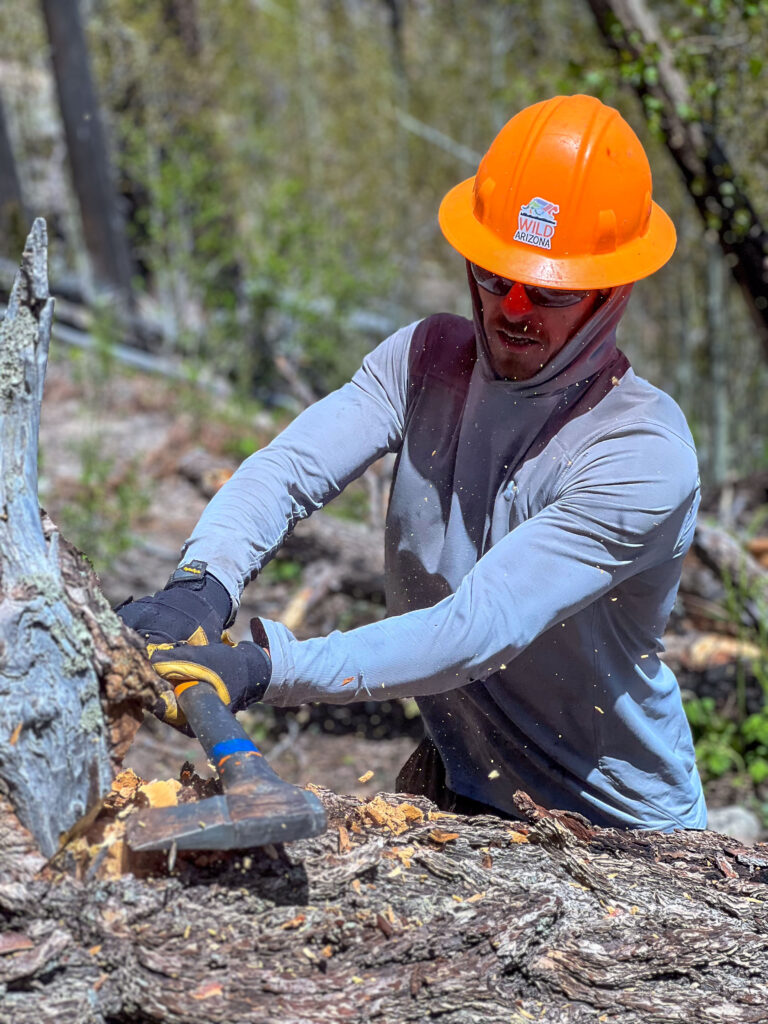
Written by Nico Lorenzen, Wild Stew Field Crew Leader.
One hundred years, a century, it’s quite a length of time; to humankind anyway. We mark major shifts in our history: the west in the 1800s evokes a wildness of a different nature than that of the modern day. A wild west characterized as much in the temperament of a pioneer or gunslinger as that of the landscape itself. Whereas our modern west lays itself in nature’s yet unconquered visage as we stand to protect it in the face of degradation at the hands of industry and the winds of a changing climate.


What about one hundred years ago? It’s likely a few lifespans for a quaking aspen, maybe a fourth of one for a Douglas fir. And an eternity in the modern social media environment. A little over one hundred years before we began this hitch we find the mention of one Aldo Leopold nestled on page fourteen of the Albuquerque Morning Journal on May 21st, 1922 where it states that he’s gone off to help fight a wildfire in the Black Range. Aldo Leopold, of course, was the one who recommended the Gila become the nation’s first protected wilderness that very same year.

In the present day, Wild Arizona’s Wild Stew Field Crew honored the eventual establishment of the Gila Wilderness by working the Centennial Trail one hundred years after the Wilderness’ inception. We worked it in much the same way that past trail crews have, clearing deadfall from the past winter and from montane winds to the tunes of singing crosscut saws who sing the same ballads across the century. We started with a modern detour, taking chainsaws and cutting to the wilderness boundary along the Crest Trail #182 of the Gila National Forest. Upon reaching the boundary the crew ascended to our upper camp at Hummingbird Saddle, a panoramic locale nestled under the snowdrift-laden peak of Whitewater Baldy. We proceeded with our wilderness tools, taking crosscut saws to the fallen aspen and fir that adorned the Crest Trail from the wilderness boundary across the peaks and saddles of Whitewater Baldy, Center Baldy and finally Mogollon Baldy. In the previous sentence I summarized what in truth was a fourteen mile round trip as we pushed through the logs across an exposed burn scar, the remnants of a 2012 stand replacement fire that has caused the trail to become nearly impassable in previous years. We got lucky. Across that seven mile stretch we removed 265 fallen trees (an all time low since the flames), opening the passage to the fire lookout on the peak of Mogollon Baldy.


Over the hitch we witnessed the unbounded benefits of that wilderness: we saw a black bear inspecting our work before retreating for its preferred wallows along the Holt-Apache Trail, we heard lobos as they sang in distant valleys and howled along the slopes of Whitewater Baldy. We stepped over elk bones as the wind through the fire-hardened aspen stands wailed with the red flag winds of the fire season. We worked along with the Gila’s own Forest Service crew and met the lookout on their first day up to the tower, an individual with the accrued wisdom of forty three seasons watching over the forest. Forty three years, that’s a few shy of a hundred, but a staggering achievement in protecting our wildlands.


With the final push to Mogollon Baldy and the resultant thirteen hour day we throttled back the next, taking a slow morning to watch the full expression of the sunrise at Hummingbird Saddle as trumpeted by the weaving calls of swifts overhead as they raced through the new stands of quaking aspen that earned their name in the early morning winds. Then we found the true nature of the task ahead, Iron Creek Trail. The trail exists in a whisper, smothered by over a decade of fallen, burned trees. It’s a sea of jackstraws, but the crew exhaled fatigue, sucked in the thin 10300’ air, and got to work. With our newer sawyers bolstered by their crash course of the Crest Trail and the veteran sawyers grinning at the puzzle of interspersed, woven, labyrinthian logjams we removed trees one ribbon of saw dust at a time. A countless number of cuts, and grunts (and maybe a few curses) as trees gave way to a trail corridor. With only two days on Iron Creek the crew made it through half a mile and an additional 229 trees. I am beyond proud of the hard work of this crew and I am excited to see what our next hitch brings back on Iron Creek Trail as we descend down the mountain. You will have to stay tuned for that, and should you find yourself on that trail trying to enumerate the amount of logs before you, I sincerely hope you are happy to count well past one hundred.














